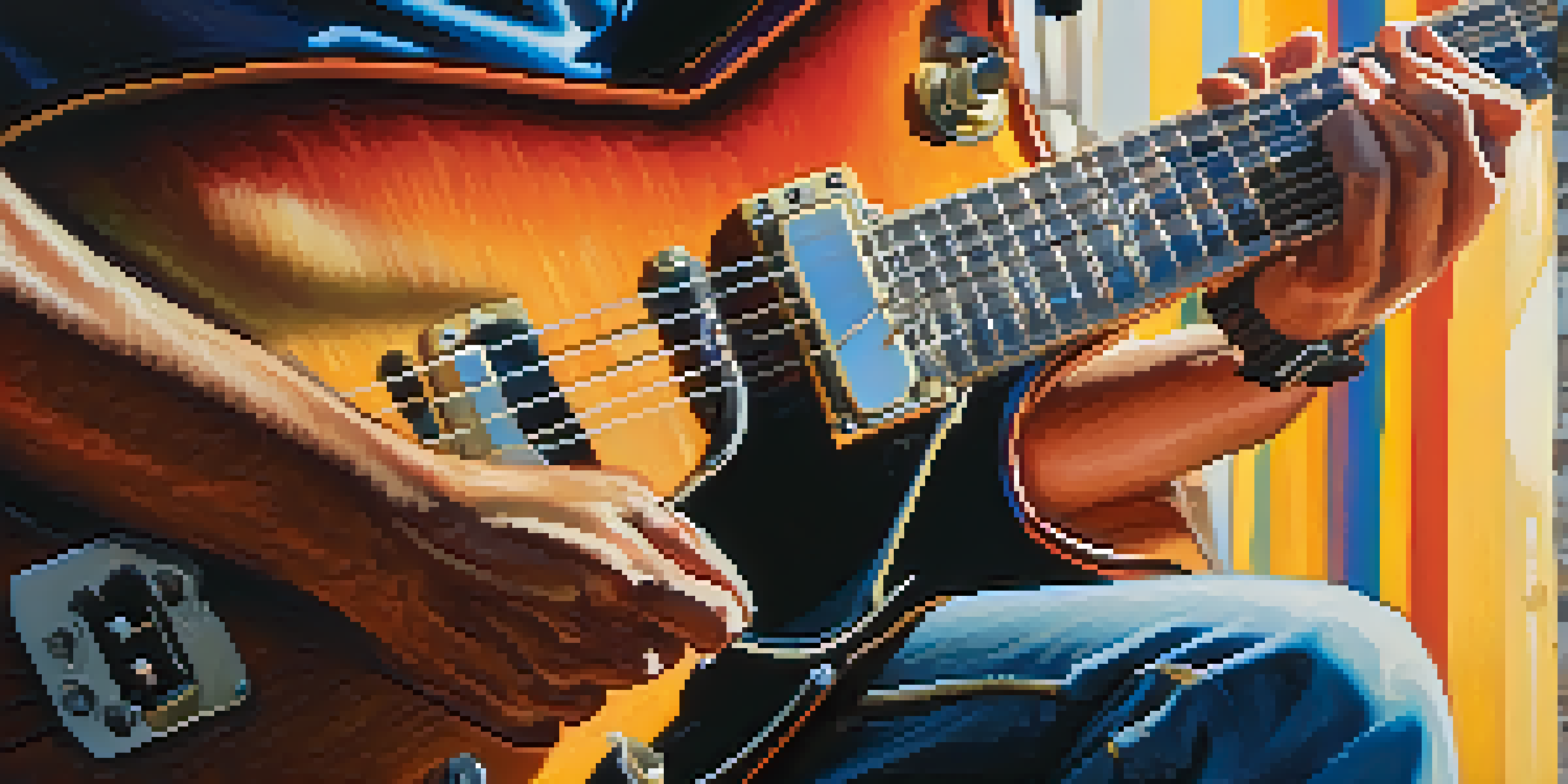Using Dynamics to Enhance Your Rhythm Guitar Playing Style

Understanding Dynamics in Music and Guitar
Dynamics in music refer to the varying levels of intensity and volume, which can dramatically change the feel of a performance. For rhythm guitar, mastering dynamics means knowing when to play softly, loudly, or somewhere in between to create a more expressive sound. This subtle art can transform your playing from flat and monotonous to vibrant and engaging.
Music can change the world because it can change people.
Think of dynamics as the emotional palette of your music. Just as a painter uses different shades to convey feelings, you can use volume and intensity to evoke emotions in your listeners. Whether it's a gentle strum during a ballad or a powerful chord in a rock anthem, dynamics help you paint a vivid musical picture.
By incorporating dynamics into your rhythm playing, you’ll not only improve your musicality but also captivate your audience. This section lays the groundwork for understanding how to harness these elements in practical ways on the guitar.
The Importance of Volume Control in Rhythm Playing
Volume control is crucial for rhythm guitarists as it allows you to add depth to your sound. Playing at different volumes can emphasize certain chords or sections of a song, helping to create a more dynamic and engaging performance. For example, strumming softly during a verse and then hitting harder during the chorus can give your playing a more dramatic effect.

Consider the dynamics of your favorite songs. Often, the most memorable moments are the ones where the music swells or retreats in volume. This contrast not only holds the listener's attention but also provides a framework for how you can structure your own rhythm playing.
Mastering Dynamics Enhances Emotion
Understanding and applying dynamics in your rhythm guitar playing can significantly evoke emotions and engage listeners.
Practicing volume control can be as simple as experimenting with your pick attack. Try playing the same chord at varying volumes to see how it changes the feel of your playing. This awareness will open up new avenues for expression in your rhythm guitar style.
Using Accents to Create Rhythmic Interest
Accents are a powerful tool in rhythm guitar that can add excitement and variety to your playing. By emphasizing specific notes or beats, you can create a sense of movement and energy that draws listeners in. For instance, if you accent the off-beats in a groove, it can make the whole piece feel more lively and engaging.
The only truth is music.
Think about how drummers use accents to shape a song’s rhythm. As a rhythm guitarist, you can mimic this technique by highlighting particular strums or notes within your chord progressions. This approach not only enhances the groove but also showcases your unique playing style.
To practice this, try playing a simple chord progression and deliberately accenting certain beats. This simple change can breathe new life into your playing and help you develop a more nuanced rhythm guitar style.
Incorporating Palm Muting for Dynamic Effects
Palm muting is a technique where you lightly rest the edge of your palm on the strings near the bridge while strumming. This creates a muted sound that can add a percussive element to your rhythm playing. It’s particularly effective in genres like rock and funk, where a tight, punchy sound is desired.
Using palm muting strategically can help you control dynamics in your playing. For example, you might use it during verses to create a more subdued atmosphere, then lift your palm for the chorus to unleash full chord resonance. This contrast can keep the listener engaged and highlight the song's emotional shifts.
Volume Control Adds Depth to Sound
Effective volume control allows rhythm guitarists to emphasize sections of a song, creating a more dynamic and captivating performance.
To master palm muting, practice switching between muted and open strumming. This will help you develop a feel for how to use the technique in various musical contexts and enhance the overall dynamics of your rhythm guitar playing.
Exploring Different Strumming Patterns for Variation
Strumming patterns are the heartbeat of rhythm guitar, and experimenting with different patterns can introduce exciting dynamics to your playing. By varying your strumming style, you can change the character of a song, making it feel fresh and invigorating. Simple variations like adding pauses or changing the direction of your strum can have a significant impact.
For example, consider a basic down-up strumming pattern. By adding a few muted strums or accents, you can create a more intricate rhythm that captures the listener's attention. This playful exploration can lead to discovering unique grooves that define your playing style.
Start by mastering a few fundamental strumming patterns, then gradually introduce variations. This practice will not only boost your confidence but also help you understand how rhythm can shift with dynamics and strumming techniques.
Dynamic Contrast: Building Tension and Release
Dynamic contrast is an essential concept in music that involves alternating between loud and soft passages to create tension and release. In rhythm guitar, this can manifest as a gradual build-up leading to a powerful chorus or a sudden drop in volume to highlight a lyrical moment. This ebb and flow can captivate an audience and enhance the storytelling aspect of a song.
Consider how a great movie builds suspense with quiet moments, only to explode into action. Similarly, your rhythm guitar can employ dynamics to create a narrative within your music. This technique can add drama and emotional weight, making every note feel intentional.
Explore Styles for Unique Dynamics
Adapting dynamics to fit different musical genres helps develop versatility and enriches your overall guitar playing style.
To practice dynamic contrast, identify sections in your favorite songs where this technique is utilized and try to replicate it. By understanding how to effectively use tension and release, you can elevate your rhythm guitar playing to new heights.
Applying Dynamics to Different Musical Styles
Different musical styles have unique approaches to dynamics, and understanding these can enhance your rhythm guitar versatility. For instance, in blues, dynamics often involve subtle variations that create a soulful feel, while in punk rock, the energy is usually high and aggressive. Learning to adapt your dynamics according to the genre can make you a more flexible and expressive musician.
Try listening to artists from various genres and pay attention to how they utilize dynamics. In jazz, you might notice a lot of soft playing interrupted by sudden bursts of volume, while country music often uses dynamic shifts to emphasize storytelling. By incorporating these elements into your own playing, you can develop a richer style.

As you explore different genres, challenge yourself to experiment with your dynamics. This practice will not only expand your musical repertoire but also allow you to express yourself more authentically on the guitar.